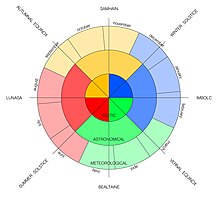This article has multiple issues. Please help improve it or discuss these issues on the talk page . (Learn how and when to remove these messages)
|

The Irish calendar is the Gregorian calendar as it is in use in Ireland, but also incorporating Irish cultural festivals and views of the division of the seasons, presumably inherited from earlier Celtic calendar traditions.
Contents
The traditional Irish Calendar uses Astronomical Timing, however Meteorological Timing is also used by organisations such as the Met Éireann. [1] Both are in use in the Republic of Ireland, however generally the Astronomical Calendar is the most commonly used. [2]
In English-language Julian calendars and its derivatives, the months are based on names from Classical mythology, such as the name "February" which derives from the Roman purification rite, Februa. In the Irish calendar, the names of the months in the Irish language refer to Celtic religion and mythology, and generally predate the arrival of Christianity. The words for May ( Bealtaine ), August ( Lúnasa ) and November ( Samhain ), are the names of Gaelic religious festivals. In addition, the names for September (Meán Fómhair) and October (Deireadh Fómhair) translate directly as "middle of harvest" and "end of harvest". Christianity has also left its mark on the Irish months: the name for December (Nollaig) derives from Latin natalicia'birthday', referring to the birth of Christ.[ citation needed ]